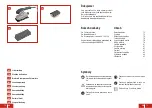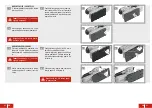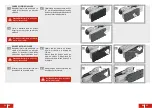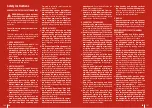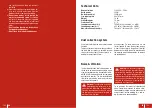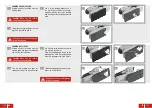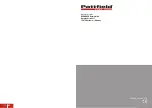
EN
102
EN
103
tion facility and keep the work area well
ventilated.
g) Ensure that you have removed foreign ob-
jects such as nails and screws from the
workpiece before commencing sanding.
h)
Do not force sander, let the tool do the
work at a reasonable speed.
Overloading
will occur if too much pressure is applied
and the motor slows resulting in inefficient
sanding and possible damage to the sander
motor.
i)
Don’t continue to use worn, torn or heav-
ily clogged sanding paper.
j)
Don’t touch the moving sanding paper.
Technical Data
Nominal voltage
230-240 V~ 50 Hz
Rated power
200 W
No-load speed (n
0
)
12000/min
Size of base plate
90 x 187 mm
Weight
1.4 kg
Orbital diameter
1.6 mm
Protection Class
/ II
Sound pressure level (L
pA
)
74.5 dB(A) / Uncertainty K = 3 dB(A)
Sound power level (L
wA
)
85.5 dB(A) / Uncertainty K = 3 dB(A)
Max. vibration emission (a
h
)
7.923 m/s
2
/ Uncertainty K = 1.5 m/s
2
Dust collection system
Use of dust collection can reduce dust-related
hazards.
To prevent personal injuries, make sure to use
the dust box or connect a suitable vacuum
cleaner to the dust port. The dust port is ca-
pable of a connector of 35 mm.
If the dust box
7
is used, make sure it is not
full or clogged. To clean the dust box, remove
it from the dust port
6
by pulling it straight
backwards. Carefully shake the dust box with
the opening pointing downwards to remove
the sanding dust.
Noise & Vibration
The declared vibration total value and the de-
clared noise emission values have been meas-
ured in accordance with a standard test meth-
od (EN 62841) and may be used for comparing
one tool with another. The declared vibration
total value may also be used in a preliminary
assessment of exposure.
Warning!
The vibration and noise
emission during actual use of the
power tool can differ from the declared to-
tal value depending on the ways in which
the tool is used, in particular, what kind of
work piece is machined.
Warning!
It is necessary to identify
safety measures to protect the op-
erator that are based on an estimation of
exposure in the actual conditions of use
(taking account of all parts of the operating
cycle such as the times when the tool is
switched off and when it is running idle in
addition to the trigger time).
Try to minimize the impact of vibration and
noise. Exemplary measures to reduce vibra-
tion exposure include wearing gloves while
using the tool, limiting working time, and us-
ing accessories in good condition.

